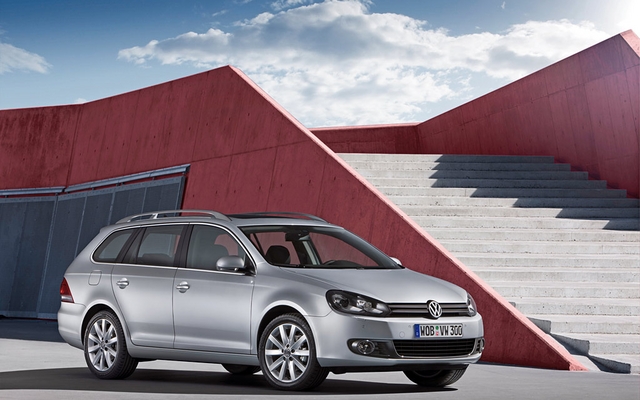2010 Volkswagen Golf Wagon TDI: The Most Practical Car in Canada?

| Strong points |
|
|---|---|
| Weak points |
|
A few years ago, when fuel prices first began their upward trend buoyed by a flotilla of excuses propped up by wars in the Middle East and Gulf Coast hurricanes, the automotive community was clearly and obviously divided into two camps. One, claiming automotive salvation in the name of superior technology, threw their support behind the burgeoning hybrid camp championed by the Toyota Prius. The second group, content to rely upon the tried and true nature of internal combustion in its most efficient form, backed the propagation of diesel drivetrains in North America, stoically headed for generations by Volkswagen’s Golf diesel. And although the contest has cooled in the years since, the two main contenders are still on fire. Setting records as one of the world’s most popular Hybrid vehicles, the Toyota Prius remains a strong seller for the beleaguered Japanese giant, while Volkswagen has distilled their long-running diesel line into this: the new 2010 Golf TDI. But has the years of contention created a clear winner? In a word; yes.
And it’s as plain as day, if you’re among the 99% of North Americans that appreciate the purity of form that is the station wagon. Still utilizing the same body structure that debuted under the last Jetta Wagon, the 2010 model trades the wide-eyed stare of that car for a more Germanic and purposeful front fascia. Although a look that’s probably best translated into the new GTI, it suits the new Golf quite well indeed, offering a significant enough update to distinguish new cars from older models, while retaining the overall shape that has made Golf wagons so imminently practical for decades.
Speaking of which, that long, traditional station wagon silhouette is one of this particular car’s most enviable strengths. Capable of swallowing in immense 32.8 cubic feet worth of cargo with the rear seats in place and a downright stupendous 67 cubic feet with both sides of the 60/40 rear bench folded, it’s capacity dwarfs that of the Prius, which can muster up just 15.7 cubic feet of available cargo room. But it’s not just the total capacity that makes the Golf Wagon such a fantastic cargo-hauler, it’s the manner in which that cargo can be stowed. While shorter trunk spaces like that of the Prius require a lot of vertical stacking to store larger items, the Jetta’s long and impressively wide interior cavity allow even moderately sized packaged to reside safely below the included cargo cover. Even the largest parcels easily lay flat on the cargo floor, proffering good sight lines and unimpeded visibility for the driver and occupants.
Occupants who, according to Volkswagen, can enjoy the most spacious cabin ever to be found within a vehicle bearing the Golf name. And although that may be true, I found the overall quality to be the most impressive aspect of this new Golf. Trading much of the cheapo plastic surfaces I so loathed in the previous Jetta, the new model is arguably better than this class’ interior quality benchmark; the Audi A3. There are lots of fine, soft-touch rubberized surfaces and plenty of fabric-lined storage bins. For traditionalists, there’s still the odd you-must-lift-the-armrest-to-engage-the-parking-brake-completely feature, but beyond that, none of the old cars’ stylistic and tactile faux-pas carry forward. The steering wheel is well shaped and possessing of some very attractive controls for manipulation of the stereo, Bluetooth and cruise controls systems. The dashboard, although of the standard Volkswagen style, is rendered in a finely surfaced rubber that feels great and should wear incredibly well. The control panels, both on the center console and to the left of the steering wheel, are well integrated in the overall design and look as good as they feel, swathed in a myriad of gloss and matte finishes with silver touches that look much better than the previous car’s painted accents.
And then of course there’s the heart of the matter: the engine. Displacing two litres and breathing through a turbocharger, the diminutive turbodiesel produces an astonishing 236 pound-feet of torque at just 1,750 rpm. In stark contrast to the manner in which hybrids must be driven in order to maximize their electronic aids, the diesel affords drivers excellent fuel economy, even when being positively thrashed. Possessing accelerative properties that will exceed most expectations, the wagon’s powerband is perfectly suited to inner-city driving, when slower speeds allow better exploitation of the high torque powerplant. Out on the highway, the quick-shifting dual clutch gearbox maximizes forward momentum, but the 140 peak horsepower does conspire against passing maneuvers as the little diesel simply runs out of steam at higher speeds.
But realistically, for most city-dwelling Canadians, how a car behaves between zero and sixty kilometers per hour is vastly more important than how a car behaves north of 120, and that is precisely why the diesel is, in my opinion, the clear winner. Lending itself far better to the cut and thrust of daily life than hybrids that require glacial acceleration to maintain electric-only operation, the Volkswagen Golf Wagon TDI may lack the flash and pizzazz of the fashionable hybrids, but is simply better at getting the job done.











